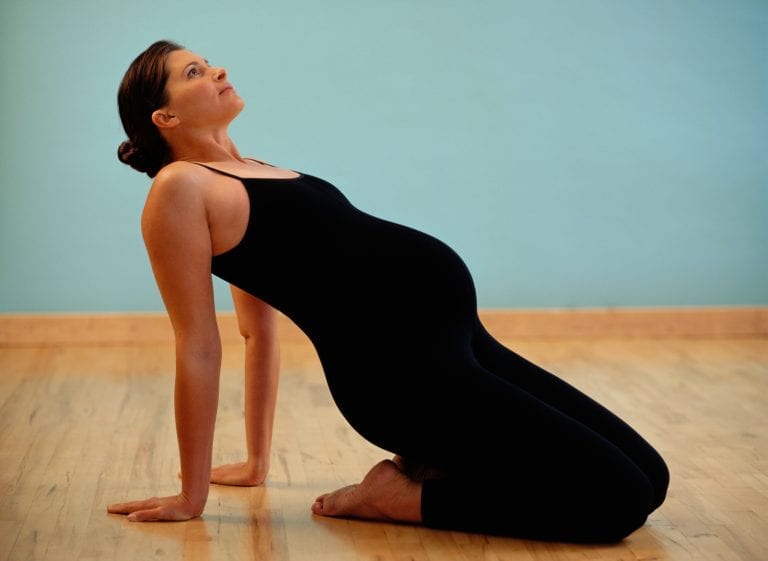Exercising is essential
Wondering if you should maintain your usual workouts during pregnancy, or if you can start a new exercise regimen now that you’re with child? Experts hands down agree that the answer to both questions is yes!
Exercise during pregnancy increases your muscle strength, boosts your immune system, reduces your risks of gestational diabetes, helps you maintain a better body image, is shown to make labor and delivery easier, and it helps you recover faster from childbirth.
First, if you’re experiencing any pregnancy complications or if you’ve been told you have a high-risk pregnancy, avoid exercise until you’ve had a chance to discuss it with your healthcare provider. If you’ve been cleared to exercise, use the following guidelines to keep moving; it not only benefits your growing body, but your baby’s as well.
Make modifications
Say you’re a runner or a regular at the yoga studio and you have an established routine. Know that as your pregnancy progresses and your center of gravity shifts, you may have to modify the intensity or length of your activities. This is true for all forms of exercise.
Avoid exercise that has increased falling risks or that could impact your abdomen or pelvic region: such as skiing, horseback riding, bicycling, and jumping, such as into a pool. Skip exercises where you lie flat on your back (like abdominal crunches) or activities like boxing. And skip the tennis or racquetball courts for now as the side-to-side movements in these sports put too much stress on the stretching and changing muscles and ligaments of your hips. And if you’re on the coasts, avoid scuba diving because of complications that can emerge from breathing compressed oxygen.
Your healthcare provider may even advise that you track your active heart rate and maintain it at reduced levels through low-to moderate-intensity activity. Here’s why: High-intensity workouts can reduce blood flow to the placenta and your baby, which is a real no-no. Just take your normal exercise routine down a notch. So if you’re an avid runner, it’s ok to continue running during pregnancy as long as you monitor your heart rate. For most pregnant women, your maximum heart rate during exercise shouldn’t exceed 110-120 beats/minute (80 percent of your maximum heart rate). Avoid becoming short of breath—you should be able to carry on a conversation during your activity in pregnancy.
Even if you don’t have a regular exercise routine, it’s okay to start during pregnancy. Just be sure to exercise at a low-intensity. It’s a good goal to try to fit in 30-40 minute workouts most days of the week. Good exercises in pregnancy include walking, swimming, low-intensity aerobics, and yoga.
Stay cool and hydrated
Avoid becoming overheated, as this can reduce blood flow to your baby. And drink lots of water throughout your workout since dehydration can cause the uterus to contract. Better yet, factor in a small snack and a sports drink or milk before exercise to maintain healthy blood sugar levels during activity.
Wear loose, comfortable clothing that won’t restrict blood flow as you move, and wear a more supportive bra.
Most of all, listen to your body and to your baby. This is not a time to diet or to lose weight through increased activity. Use exercise to keep yourself feeling fit and strong as you experience the changes of pregnancy. Don’t overdo it, and never workout to the point of exhaustion. Just get out there and move around: your body and your baby will ultimately thank you for it!
Exercise warning signs
Stop your activity and call your healthcare provider immediately if you experience any of the following:
-
- Pain in your pelvic area, particularly if sudden or severe
- Bleeding or fluids leaking from your vagina
- Cramping or contractions that continue after you stop exercising
- A sudden, severe headache
- Dizziness or blurry vision
- Shortness of breath that remains after you stop exercising
- Nausea or vomiting
Try these workout modifications during pregnancy:
| RUNNING AT HIGH INTENSITIES | Alternate jogging with low-intensity running; or try running in a pool to decrease the impact to your joints and hips | ||||||||||||
| JOGGING | Alternate slow jogging with medium-intensity walking | RACE WALKING | Alternate a slow jog with a slower walk | YOGA OR PILATES | Continue to do both but avoid poses that put you on your back or stomach, including backbends, and avoid poses that put extra force on your hips; modify as you progress with extra cushioning, blocks, or a sturdy chair for extra support < |
CYCLING | Try stationary cycling, taking periodic breaks to relieve the pressure on your pelvis | SPINNING | Opt for stationary cycling at lower intensities; keep your heart rate under 120 bpm | STEP AEROBICS OR OTHER DANCE-TYPE HIGH-INTENSITY AEROBICS | Go for low-intensity classes or an elliptical machine; avoid sudden or sharp movements of any type | MEDIUM- OR HIGH-INTENSITY FLOOR AEROBICS | Take your routine into a pool and monitor your heart rate; the buoyancy will lift the pressure from your joints and pelvis |






Comments are closed.